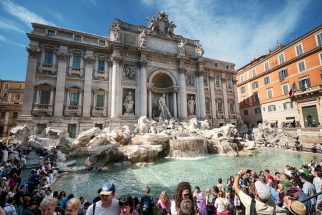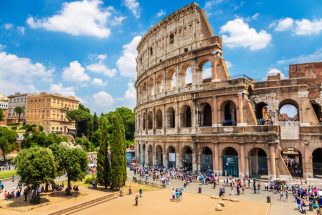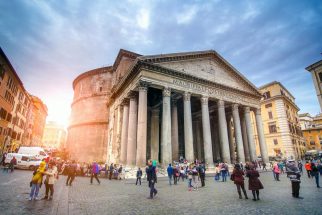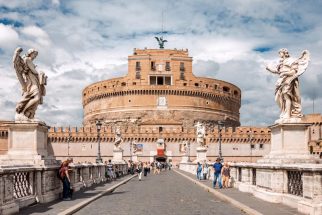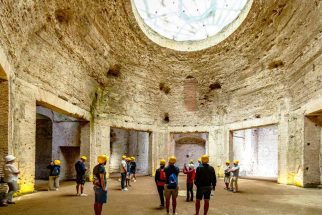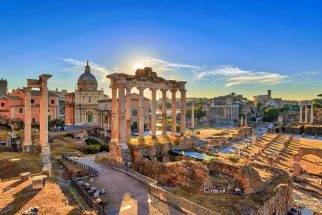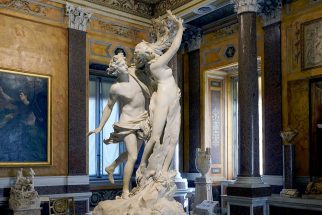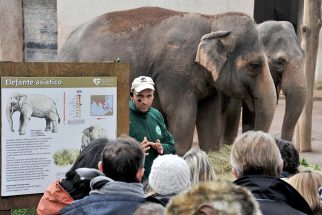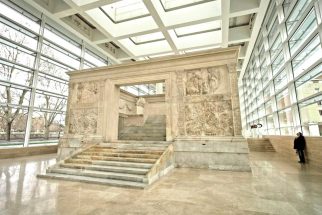The Trevi fountain is probably the most famous fountain in the world and it is certainly the largest and most spectacular of the approximately 50 monumental fountains that adorn the streets and squares of Rome. Tourists love to continue the time-honoured custom of throwing a coin into its waters to ensure their return to the Eternal City.
When you visit the Trevi fountain be sure to toss a coin into its waters. Please don’t be tempted to follow in the footsteps of Anita Ekberg and Marcello Mastroianni in the film “La Dolce Vita”, by walking or swimming in the fountain, or you may face a 500 euro fine. Times have changed a lot since 1960! The waters of the Trevi fountain are usually flowing, but sometimes they are turned off in the early morning for maintenance work. To avoid any disappointment you should visit the fountain after 9am, or in the evening when it is illuminated to further enhance its romantic and scenographic appeal.
How to best experience Trevi fountain?
Tickets, tours, and activities for Trevi fountain are available at these providers:
Click on the logos below to easily compare prices.





Feeling lucky? Try the direct search:
GetYourGuide.com Viator.com Trip.com Expedia.com Tiqets.com Ctrip.com (中文)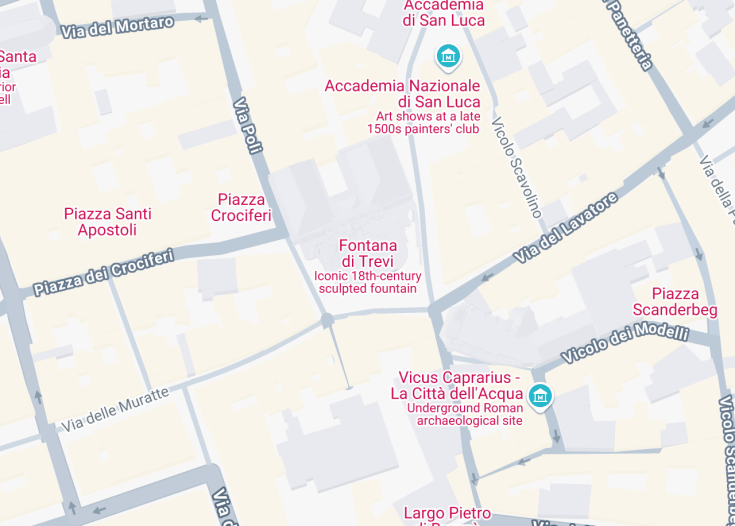
Best Trevi fountain Tickets
Tickets for Trevi District Underground: Small Aqueduct Domus
/5Descend beneath Rome and see an archaeological site dating back to the empire
As low as
€12.00
on Tiqets.com
Best Trevi fountain Tours
Tickets for Navona Underground, Pantheon and Trevi Fountain Walking Tour by Night
/5Set foot in Rome's hidden ancient treasures and see beyond the sights
As low as
€42.00
on Tiqets.com
Tickets for Trevi District Underground: Aqueduct and Domus Guided Tour
/5Journey underground with a trip beneath the Trevi Fountain
As low as
€29.00
on Tiqets.com
Rome: Trevi Fountain and Underground Guided Tour
/5Explore one of the top highlights of Rome with an expert guide. Visit the Trevi Fountain and visit the ruins of the ancient aqueduct 9 meters below ground.
As low as
€35
on GetYourGuide.com
Rome Fountains and Squares Morning Tour with Lunch
/5A walking tour among the Fountains and Squares of Rome, Spanish Steps, Trinità dei Monti, Piazza Navona, the Pantheon, and Trevi Fountain. During the tour you will get to know the Roman street food.
As low as
€95
on GetYourGuide.com
What is the Trevi Fountain?
The Trevi fountain (in Italian Fontana di Trevi) is the spectacular termination of the ancient Acqua Vergine aqueduct, built in the first century C.E. to bring natural spring water to Rome. It was commissioned in the 17th century but it took over a hundred years to plan and finish the monumental structure in the flamboyant late Baroque style. The Trevi fountain features in several famous movies, including Fellini’s La Dolce Vita.
Why was the Trevi Fountain built?
The Trevi fountain was constructed as a monumental celebration of the Acqua Vergine aqueduct, which had provided the Romans with clean water for drinking and washing for hundreds of years. This aqueduct was completed in 19 BC by Agrippa, the collaborator of Emperor Augustus. It ran almost entirely underground for 22 kilometers and after being repaired several times it was replaced by a modern pressurised aqueduct in the 1930s.
The massive construction that we see today was planned by the Roman architect Nicola Salvi, who died before it was completed in 1762. The central statue represents the sea god Oceanus, with mermen and aquatic horses below him, flanked by allegorical female figures on the imposing architectural backdrop of Palazzo Poli. The statues, and the reefs and rocks on which they stand, are sculpted from white travertine stone. At least four popes were involved in the project, which Pope Urban VIII originally entrusted to the great architect and sculptor Gian Lorenzo Bernini in around 1640.
What are the legends of the Fountain?
The name of the Acqua Vergine aqueduct literally means “Virgin Water” because according to a legend (depicted in a bas relief on the fountain) a maiden led Agrippa’s soldiers to a pure and uncontaminated natural spring east of Rome, which fed the river Aniene and then supplied the aqueduct.
Another legend states that if you toss a coin over your left shoulder into the basin of the fountain, you will return to Rome one day. This dates back to the ancient Roman tradition of throwing coins into water to ensure the protection of the gods and a safe return after a journey overseas. A variant of this legend, made famous by the movie Three Coins in a Fountain, says that if you throw three coins into the fountain at once, you will also meet the love of your life and get married.
Even if you don’t believe in the fountain’s magic powers, please bear in mind that the coins are used for a good cause, as they provide supermarket groceries for the poorest people of Rome. In high season as much as 3,000 Euros can be collected every day.
General information
Useful information for your visit to the Trevi Fountain.
Location
The Trevi Fountain is located in the square called Piazza di Trevi, at the convergence of four streets: Via della Stamperia and Via Poli, which both lead to Via Barberini to the north, and Via del Lavatore, which continues on the eastern side of the fountain with the name of Via delle Muratte (leading to Via del Corso).
Opening hours
The Trevi Fountain is an open-air monument which is always open although the water may be turned off for maintenance work (usually only in the early morning).
How to get to the Trevi Fountain
To reach the Trevi Fountain you can travel by: Metro. Take the Metro line A to Barberini, from where you can walk about 200 meters west on via Barberini (after admiring Bernini’s Triton fountain in the middle of Piazza Barberini) and turn left onto Via della Stamperia. After 100 meters you will come to the fountain (click to see the guide to the Metro). Bus. Municipal bus numbers C3, 51, 53, 62, 63,71, 80, 83, 85, 100, 117, 119, 160 and 492 all have stops that are very near the Trevi Fountain, either on Via Barberini, 70 meters to the north or on Via del Corso, 120 meters to the west. Taxi. This is an effective but rather costly way to get around Rome (click to see the guide to taxis in Rome). Limo service (NCC). A rental service with driver (click to see the guide to limo services in Rome).
Attractions nearby
- The Quirinal Palace (200 m to the south east)
- Piazza Colonna (278 m)
- Piazza del Quirinale & Palazzo del Quirinale (318 m)
- Galleria Doria Pamphilj (372 m)
- Piazza Venezia and the Capitoline Hill (400 m to the south – at the end of Via del Corso)
- The Imperial and Roman Forums (450 m to the south – beyond Piazza Venezia)
- The Pantheon (400 m to the west)
- Piazza di Spagna & The Spanish Steps (Piazza di Spagna) (542 m)
- The Mausoleum of Augustus and Ara Pacis (550 m to the north west)
- The Triton fountain at Piazza Barberini (546 m to the east)

